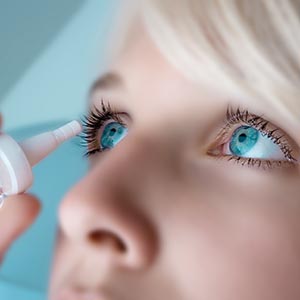DRY EYE TECHNOLOGY IN WESTLAKE
When tears decrease in frequency,
Dry Eye is typically the result.

Dry Eye Syndrome Treatment
Typically, Dry Eye Syndrome DES is treated with medicated eye drops, anti-inflammatory drops, or a heated compress. Occasionally, the doctor may recommend punctal plugs. These are tiny devices that are inserted into the eye’s tear duct, blocking any drainage. This can alleviate DES symptoms by preventing moisture from draining out of the eye, instead keeping them inside the tear duct area. This increases the moisture level, giving longer-term relief. Plus, punctal plugs are not permanent and can be easily removed or replaced, making them a simple, affordable solution to alleviate symptoms.
What is Dry Eye Syndrome?
Dry Eye Syndrome, referred to as DES, is a chronic eye condition that occurs when the eyes produce an insufficient amount of tears or when the tears lack the essential oils that lubricate the eye’s surface. (This often results in watery eyes and excessive tearing!). A well-lubricated eye blocks foreign bodies or substances from irritating the eye’s surface.
Dr. Robert Soltys treats patients from all over Westlake, Texas who have Dry Eye symptoms, helping them achieve long-lasting relief from Dry Eye Syndrome.


What Causes Dry Eye?
Dry Eye can result from a number of factors, including genetics, the natural aging process, or prescription medications, to name a few.
Hormonal changes are a common cause of Dry Eye. In fact, women who are pregnant, breastfeeding, taking oral contraceptives, or experiencing menopause find that their eyes feel dry and uncomfortable during these times. Women over the age of 50 have a 50% greater chance of developing DES than men of the same age.
Dry Eye Treatment and Relief
Those who suffer from DES often try to alleviate the pain by blinking either less or more often, rubbing their eyes, or by using over-the-counter artificial tears.
Why is blinking important? Blinking is healthy because it naturally moisturizes the eyes and gets rid of tiny particles that may enter the eye. Less blinking can increase dryness, itching, or redness, making DES symptoms even more acute.
Rubbing your eyes, especially when they’re already irritated, can intensify your symptoms. This is because the added pressure can make the pain worse. If your hands aren’t 100% clean, you can unintentionally spread germs or bacteria into your eyes when you rub them. Rubbing the eyes can also cause tiny blood vessels to break, increasing the redness of your eyes.
Artificial tears provide some temporary relief by lubricating the eyes with a medicated solution. These can be quite effective at alleviating soreness and itchiness, however, excessive use isn’t recommended. Many brands include preservatives, which aren’t good for your health in the long-term. Other preservative-free brands can, over time, fail to relieve the basic Dry Eye symptoms. Patients may find that having to continuously purchase artificial tears can become costly, and consistently using them throughout the day disrupts their daily activities.
Common Symptoms of Dry Eye
Patients with DES experience a number of symptoms that can disrupt their daily activities or cause chronic pain.
The most common signs of DES include the following:
- Blurriness
- Burning
- Dryness
- Feeling as if something is in your eye
- Irritation
- Itchy eyes
- Pain
- Red eyes
- Stinging
- Watery eyes
